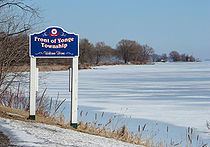Time zone EST (UTC-5) Website www.frontofyonge.com | County Leeds and Grenville Postal Code K0E Population 2,803 (2006) Area code 613 | |
 | ||
Front of Yonge is a community found in the United Counties of Leeds and Grenville, it is the home of the Thousand Islands National Park, Brown's Bay Provincial Park, as well as a number of private campgrounds, the Jones Creek walking trail system, and the 1000 Islands Waterfront Trail’s walking/bike path which from just beyond the Township’s eastern boundary to neighbouring towns. The predominance of the Canadian Shield produces scenic and diverse landscapes which include exposed rock formations and heavy tree cover, as well as wide fields and beaches.
Contents
Map of Front of Yonge, ON, Canada
Location
Front of Yonge is located along the St. Lawrence River in the Thousand Islands region. Part of the Frontenac Arch Biosphere Reserve, Front of Yonge can be found between the larger towns of Brockville to the east, and Gananoque to the west. Approximately 135 kilometres (84 mi) away from Ottawa and 325 kilometres (202 mi) from Toronto, Front of Yonge is within driving distance to many of the larger cities of Ontario. The township comprises the communities of Ballycanoe, Caintown, Mallorytown, Mallorytown Landing, McIntosh Mills, Trevelyan and Yonge Mills.
Mallorytown
The largest settlement area of the township is the Village of Mallorytown, founded by United Empire Loyalist Nathaniel Mallory. He came ashore at Mallorytown Landing in 1784, and later moved inland in search of better farmland. This village is the site of Canada's first glassworks factory, which began in 1839, and closed in 1840. Only a few pieces of Mallorytown glass still exist, the most famous being the ‘Mallorytown Pitcher' which is on display at the Royal Ontario Museum. A reproduction of this piece is currently on display at the Mallory Coach House, an 1850's stone home which has been renovated and is open to visitors on weekends during the spring and summer months.
Mallorytown Landing
Mallorytown Landing is situated on the St. Lawrence River and is the location of the Visitor Centre for the Thousand Islands National Park, which comprises several ecologically important mainland properties and more than twenty islands between Kingston and Brockville. Established in 1904 as the first Canadian national park east of the Rockies, it is also the smallest of the national parks.
History
Front of Yonge is named for the Right Honorable Sir George Yonge, a British Secretary during the War of 1812. Officially designated as Front of Yonge in 1859 this township, the nearby Front of Escott and Front of Lansdowne were the only three municipalities with "Front" in their names because they all border the St. Lawrence river. Years later, both Escott and Lansdowne were assimilated into another municipality. That left Front of Yonge the only township in Ontario with "Front" in its name. Also named after Sir George are Yonge Mills Road and Townline Road Escott Yonge in this township, as well as Yonge Street, the main arterial road in Toronto.
The area was settled by a strong core of United Empire Loyalists after the American Revolutionary War who participated in the War of 1812. Mallorytown Landing was a port for ships moving supplies and a blockhouse was constructed on Chimney Island to protect the vessels. The chimney remains standing today as a National Historical site.
Demographics
Population trend:
Private dwellings occupied by usual residents: 1065 (total dwellings: 1218)
Mother tongue:
